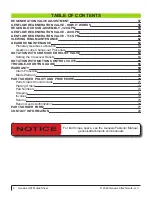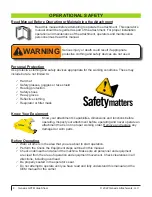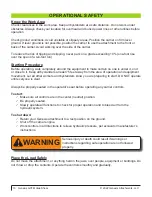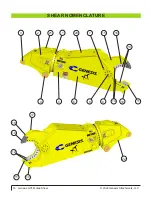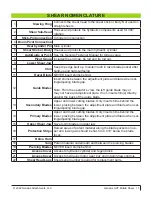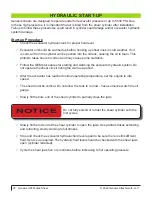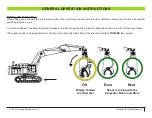
© 2022 Genesis Attachments, LLC
Genesis GXT Mobile Shear
20
!
WARNING
Be sure hydraulic pressure is relieved before
disconnecting hydraulic fittings. Remove necessary fittings
SLOWLY.
The attachment is usually shipped in an upright position. Extreme care must be used when
inverting the attachment for installation.
Follow the excavator OEM’s removal and safety instructions to remove the bucket or other stick
attachments.
Position the attachment upside down on flat, solid ground. Blocking may be required to raise the
mounting bracket into proper position.
Track the excavator to the attachment with the jaws facing the
operator. Lift the excavator stick over the attachment, carefully
positioning the stick tip connection with the attachment mounting
main pivot bore. Pin the excavator stick to the attachment.
Slowly raise the boom to lift the attachment, allowing the
cylinder pivot connection to come within range of the excavator
cylinder stroke.
Extend the excavator cylinder until the power link bore lines up
with the cylinder pivot connection. Pin the excavator cylinder to the
attachment.
Crowd and extend the attachment, checking closely to make sure
there is no interference between the bracket and hard lines. Also
check for interference between the cylinder and boom/stick.
Install excavator hydraulic hoses, supply and return, from the stick
tip to the attachment manifold blocks.
The stick and bucket circuits are oriented as to rod and bore
sides of their respective cylinders. Be sure to connect rod-to-
rod and bore-to-bore when connecting a circuit to the attachment. When these are reversed,
extra pressure is needed to open the jaw, which pulls down the engine, de-strokes the pumps,
increases jaw cycle time, creates high oil temperature and burns more fuel.
The attachment must be vertical before putting oil into it or an air lock in the regen valve may
prevent the jaw from opening.
SHEAR INSTALLATION
!
WARNING
Removing any connecting pin may be hazardous. To remove
a connecting pin, position the attachment on the ground and
properly support.
Particles may fly when a pin is struck. Use a drift pin or mallet
when striking pins. Keep all personnel at a safe distance.

